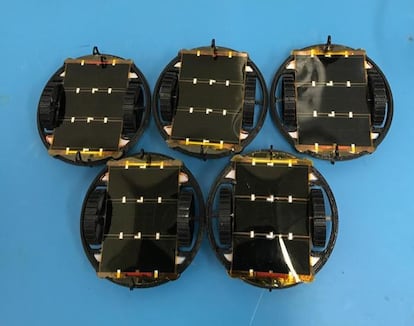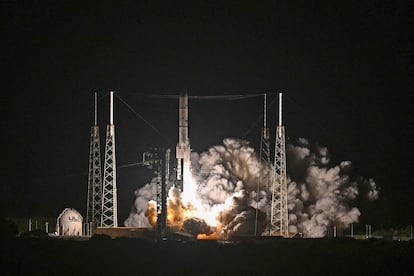Mexico’s space ambitions carried by five robots on the way to the Moon
The devices of the Colmena project, run by UNAM and the Mexican Space Agency, are aboard the ‘Peregrine 1′ spacecraft, which suffered a critical fuel leak that is jeopardizing the mission

Five Mexican microrobots are currently traveling to the Moon. They are aboard the Peregrine 1 spacecraft, which took off early Monday morning from Cape Canaveral, Florida, and should reach the satellite in about six weeks. Although the takeoff was a success, the spacecraft has since suffered a fuel leak and this has seriously jeopardized the mission, which is the first private initiative to the Moon. It is also the first time that Mexico is taking part in an expedition to the lunar surface. Leading the mission are the Autonomous University of Mexico (UNAM) and the Mexican Space Agency, which have named the project Colmena (hive), in honor of these small robots which work as a team like a hive of bees. Together, the five microrobots weigh no more than 300 grams. Mexico’s dreams for space exploration are currently wrapped in a cookie packet as they travel to the Moon.
The next space race has already begun. Countries no longer just want to set foot on the Moon, but also to create bases to take advantage of its materials and settle the first colonies. And from these colonies, prepare to travel to Mars in about 20 years. It’s a massive plan. Governments such as the United States and Russia have been investing in space exploration for decades, followed by China — which has landed on the Moon three times in the last 10 years — and India. In this extremely competitive industry, in which the European Union and the Japanese Space Agency have stakes, Mexico is trying to find its niche. It’s not easy with so many years of disadvantage. In its bid to break through, the Colmena project was born.
Researcher Gustavo Medina, head of the Space Instrumentation Laboratory at the UNAM Institute of Nuclear Sciences, and head of the mission, believes he has found a niche in small robots. While other countries are building large robots and vehicles, Mexico is specializing in nanotechnology, which allows many robots to be created. They’re tiny but efficient, like bees, which Medina describes as “simple beings that together manage to do great things, because there are many of them, and they know how to cooperate.” He continues: “Instead of sending a big machine to extract a mineral, which costs a lot and if it breaks everything is lost, I can send 100,000 tiny robots, and if one dies nothing happens. The project can go on. That’s the philosophy.”
That’s how the Colmena mission began to take shape in 2015, when Mexico presented the project to the company Astrobotic Technology, the creator of Peregrine 1 and which, sponsored by NASA, is in charge of the trip. The company selected UNAM’s idea for the first ever commercial mission to the Moon, along with 19 others from NASA, Germany, Japan and the United Kingdom. The spacecraft is also carrying a time capsule with messages from 80,000 children around the world and the ashes of Star Trek creator Gene Roddenberry, science fiction writer Arthur C. Clarke and three presidents of the United States: George Washington, Dwight D. Eisenhower and John F. Kennedy.

With sensors and fins: designed to survive
The budget for the Mexican project was 13 million pesos (about $770,000), which came equally from the Mexican Space Agency and the National Council of Science and Technology. Six million pesos were spent on creating the robots, a project which involved 250 UNAM students from the engineering department, as well as the fields of mathematics, physics, chemistry, art and law. The other seven million pesos were for the launch with Peregrine I.
Colmena is made up of five robots measuring 12 centimeters in diameter and weighing 56 grams each. They have wheels and fin-like contraptions. They are powered by energy they get from their solar panels, which are flexible to withstand the vibration that comes with being launched in a special rocket. They also have sensors, microprocessors and an intelligence system to navigate autonomously, as well as radars to move around and communicate with other robots. Never have such small devices operated in space, Medina says proudly. “They are designed to learn what the challenges are to make such a tiny, sophisticated thing and have it travel through space and survive, get to the Moon and survive.”
The Moon is a very hostile environment, with drastic changes in temperature, radiation, lunar dust and impacts of interplanetary material. So, the first objective of the robots is to review which design strategies are useful for survival and to identify problems that their creators have not yet imagined, “but which certainly exist,” says Medina. The second goal is scientific: to understand the behavior and characteristics of the Moon’s soil; to learn about the layer of smaller grains that float 20 to 30 centimeters above the lunar surface; and to observe how telecommunications work in this area and the “properties that have never been measured.”
A space catapult
The small size of the microrobots also opens up many questions. Medina explains that for the super-light microrobots, stepping on the surface of the Moon is not the same when the dust is compacted as it is when the dust behaves differently, “like a kind of fluid.” To address this issue, the scientist says that the robots have paddles to help them “navigate,” as well as four-centimeter wheels. Traveling over the surface of the Moon is the last phase of the mission. Before they can do that, the robots have to survive the launch and landing. According to Medina, for their protection, they are wrapped up in a kind of cookie package, along with a deployment and telecommunications module called TTDM, which has several functions. It can receive the information that the robots collect on the Moon, while it remains on the spacecraft to connect and transfer the data to Earth. It also works as a catapult.
Medina laughs as he explains: “If it worked for the Romans, why not for us?” When the spacecraft reaches the Moon, there is nothing to lower the robots. So the TTDM will become the first space catapult and fling the robots about 10 to 15 meters away. It is important that they land far away, as they depend on solar energy, and landing in the shadow of the spacecraft would be a death sentence. “They can fall belly up or belly down, that’s why they have solar panels on both sides,” explains the researcher. Then they have to “form a coordinate system so that they know where their companions are: they have to do that autonomously, because we don’t know where they are going to fall.”
That would have been the plan. However, an incident during the spacecraft’s propulsion caused a critical loss of fuel, meaning it will be very difficult for Peregrine 1 to reach the Moon. In its latest statement, Astrobotic Technology said the lander will run out of power within 40 hours due to the fuel leak. Peregrine is solar-powered, but requires fuel to keep the spacecraft in a stable direction pointing toward the sun. “At this time, the goal is to get Peregrine as close to lunar distance as we can before it loses the ability to maintain its sun-pointing position and subsequently loses power,” the company said in an update.
When discussing the project with EL PAÍS, Medina had already contemplated the possibility that the five robots would not be able to land on the Moon. “If they don’t make it, the mission was a success, from the moment they were able to get on the rocket,” he says. “It’s a bit unrealistic to talk about failures when you’re doing something so innovative and so far-reaching, what you have are setbacks and the important thing is not to fall, it’s to get up. We are already building the second mission.”
Sign up for our weekly newsletter to get more English-language news coverage from EL PAÍS USA Edition
Tu suscripción se está usando en otro dispositivo
¿Quieres añadir otro usuario a tu suscripción?
Si continúas leyendo en este dispositivo, no se podrá leer en el otro.
FlechaTu suscripción se está usando en otro dispositivo y solo puedes acceder a EL PAÍS desde un dispositivo a la vez.
Si quieres compartir tu cuenta, cambia tu suscripción a la modalidad Premium, así podrás añadir otro usuario. Cada uno accederá con su propia cuenta de email, lo que os permitirá personalizar vuestra experiencia en EL PAÍS.
¿Tienes una suscripción de empresa? Accede aquí para contratar más cuentas.
En el caso de no saber quién está usando tu cuenta, te recomendamos cambiar tu contraseña aquí.
Si decides continuar compartiendo tu cuenta, este mensaje se mostrará en tu dispositivo y en el de la otra persona que está usando tu cuenta de forma indefinida, afectando a tu experiencia de lectura. Puedes consultar aquí los términos y condiciones de la suscripción digital.
More information
Archived In
Últimas noticias
‘Sleepless City’: The light of cinema illuminates Madrid’s Cañada Real shantytown
All the effects of gentrification in one corner of Mexico’s Colonia Roma
Palestinian reporter Youmna El Sayed: ‘My family told me I had to choose between being a journalist or a mother’
The new language of the workplace: Knowing how to ask AI questions is more important than using it
Most viewed
- The low-cost creative revolution: How technology is making art accessible to everyone
- Christian Louboutin: ‘Young people don’t want to be like their parents. And if their parents wear sneakers, they’re going to look for something else’
- US sanctions against jailed cartel leader ‘El Marro’ highlight Mexico’s lack of control over its prisons
- Liset Menéndez de la Prida, neuroscientist: ‘It’s not normal to constantly seek pleasure; it’s important to be bored, to be calm’
- ‘El Limones’ and the growing union disguise of Mexican organized crime











































